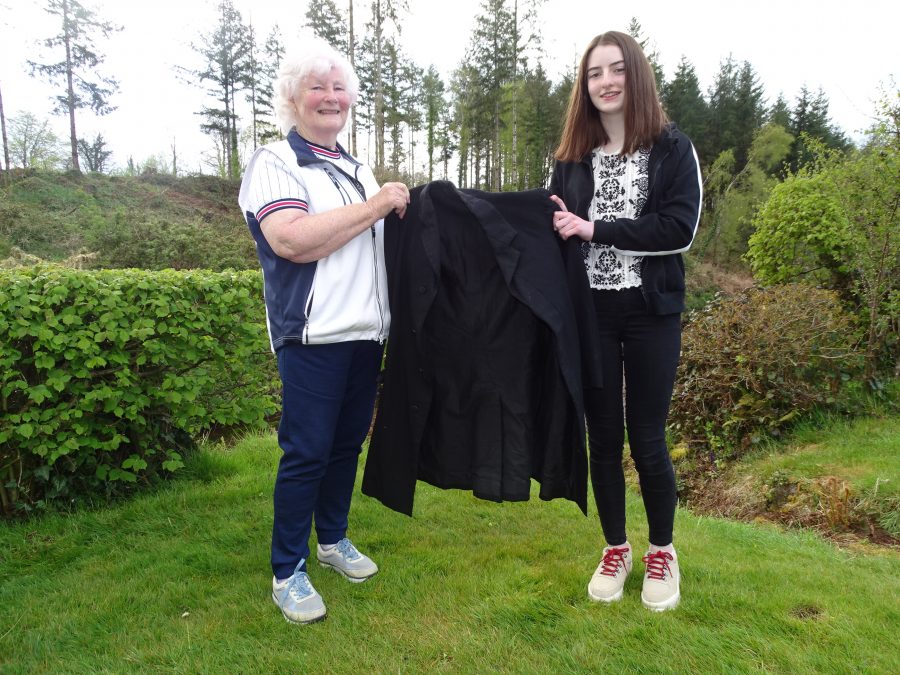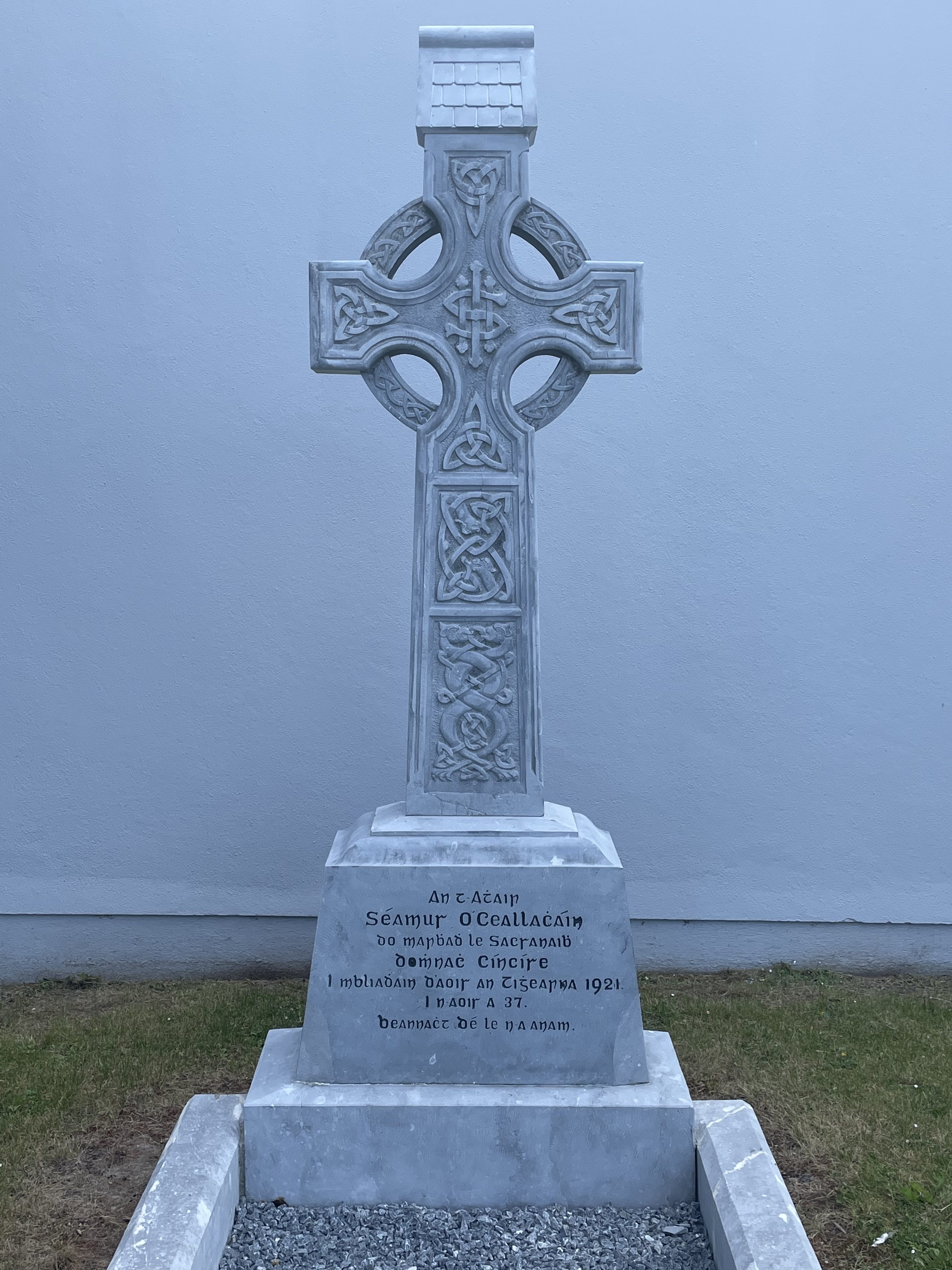30 May 2021, “Mr McCarthy said it is a “really disappointing” decision and “there must be accountability for all involved.” On Twitter, he wrote: “There was no need for The Sextant to be knocked until plans were tied down fully”, A terrible precedent for the city’s historic buildings’ — plan to scrap apartments for offices criticised, ‘A terrible precedent for the city’s historic buildings’ — plan to scrap apartments for offices criticised (irishexaminer.com)
Monthly Archives: May 2021
Cllr McCarthy: Marina Park Phase 1 Opening Delayed Until Late September 2021
In a recent reply to a question posed by Cllr Kieran McCarthy at the mid May City Council meeting, Cork City Council have noted revised the completion date of phase 1 of Marina Park. Due to Covid 19, delaying construction works, the completion date is now late August/early September this year. The revised opening date is late September/early October.
Cllr McCarthy noted: The phase one works comprise the construction of a new public car park at the Shandon Boat Club end of the Marina, as well as a new cycle lane and pedestrian walkway – these are all now completed. One can also see that the installation of perhaps the most eye-catching part of the project – a noticeable red steel pavilion on the site of, and replicating, the central hall of the former Munster Agricultural Showgrounds. The sides of the pavilion will not be enclosed, and there will be possibilities for coffee pods and outdoor seating and arts and crafts”.
“Another feature will include water jets for children to play in as well as the provision of public toilets. The public can now see the sunken lawn areas and the diversion of a watercourse, as well as new pathways – all of which are taking shape at present. The project is a e.10m investment into the area, of which nearly came from EU Urban Sustainable Funds, which are part of the EU’s structural funds and are a crucial source of funding for cities”, concluded Cllr McCarthy.
Kieran’s Our City, Our Town, 27 May 2021
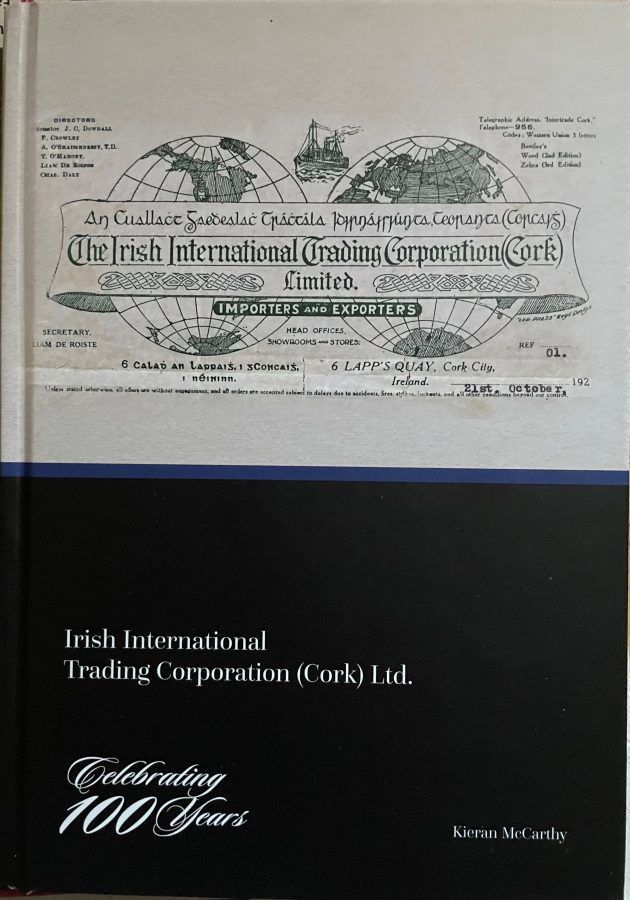
Kieran’s Our City, Our Town Article,
Cork Independent, 27 May 2021
Journeys to a Truce: The Irish International Trading Corporation (Cork)
Details on the tit-for-tat violence between the IRA and Black and Tans during the War of Independence fill vast pages of Irish history books. However, not much is known on those who were Independence supporters in Ireland’s cities and regions, but who were also pragmatic and economically preparing for a Brexit of sorts from the British Empire. The question of “if we get Independence what do we do next” had not been quite resolved especially where Britain was also Ireland’s main trading ally.
To resolve such a question in Cork city and region the creation of Irish International Trading Corporation (Cork) was set up in 1920 to facilitate international trade, both import and export, for local businesses. Its story is the subject of my new book, which is published by the present company, whilst also charting its journey in more modern times.
The company’s origins lay in the ambition of the Cork Industrial Development Association (IDA), which was founded in 1903 after the Cork International Exhibition. During the Irish War of Independence period, the Cork IDA played no small part in formulating schemes for the economic rehabilitation of the country. Without the cooperation of the Cork IDA, the Irish Consuls resident at New York, Paris and Brussels would have been very much restricted in their Consular activities on behalf of the trade and commerce of Ireland. Important national work was conducted through the agencies of these Consuls, for which the Cork IDA kept business connections open with.
In 1920 two important companies are highlighted as closely linked to the work of the Cork IDA – (a) Messrs Dowdall and Company, Shipping Agents of the Direct Lines to USA and French ports, and (b) the Irish International Trading Corporation (Cork) Ltd. The first named company aimed to promote direct trade whilst IITC aspired to build up business by purchasing from and selling direct to Continental and American firms. A gentleman’s agreement stood that no goods would be introduced into the Irish market, which would compete unfairly with the products of Irish industries.
The proposal to form the Irish International Trading Corporation (Cork) Ltd for the development of direct trading between Irish merchants and traders of other countries was generally welcomed by commercial circles in Cork. The company was in effect a private, self-help version of what state agencies do to support trade.
On 4 May 1920, the Cork Examiner recorded a preliminary meeting of persons interested in the company, which was held in the offices of the Cork IDA, under the Chairmanship of Mr James C Dowdall. Steps were taken to have the prospectus issued at an early date. Promises of substantial financial support were forthcoming from those present. The promoters aspired to secure outward as well as inward cargo for the vessels then running between Cork and the United States ports, and also for the vessels about to run between Cork and Continental ports. The company’s temporary offices were at 27 Grand Parade.
Central to the work of the Irish International trading Corporation (Cork) Ltd was its Company Secretary Liam De Róiste (1882-1959). Liam was an original member of the Irish Volunteers in Cork. In late 1916 and throughout 1917 Liam was an important figure to keep the re-organisation of Sinn Féin going in Cork, especially with Terence MacSwiney and Tomás MacCurtain being imprisoned for long periods of time during the years 1916-1918. Liam kept the re-organisation of the party strong, being involved in organising rallies in Cork in late 1917 for Arthur Griffith, Countess Markievicz, and Eamon de Valera. He was elected a Sinn Féin Councillor for Cork City in January 1920.
The American link for the new company was Diarmuid J Fawsitt who was born near Blarney Street in Cork’s northside in 1884. Diarmuid was active in cultural, industrial and nationalist circles, including the Celtic Literary Society, Sinn Féin, the Gaelic League, Cork National Theatre Society, and especially with the foundation of the Cork IDA. During the War of Independence, Arthur Griffith sent Fawsitt to the United States as consul and trade commissioner of the Irish Republic. He was based in New York.
With Fawsitt in New York searching for opportunities, Liam De Róiste as an enthusiastic secretary of the Corporation, a strong chairman was also required to lead the new company. James Charles Dowdall had a prominent role in industrial development and was president of the Cork IDA for a time in its early years. He was educated at the Presentation Brothers College, Cork, and in Denmark and Sweden. On the death of their uncle, James and his brother Thomas joined with their cousin, Mr J B O’Mahony, in forming the now well-known firm of Dowdall O’Mahony and Company Ltd. This company was based at Union Quay, Cork, with branches at Manchester and Cardiff and was engaged in the manufacture of butter and margarine.
As the months passed in 1920 and 1921, the business of Irish International Trading Corporation (Cork) expanded. By December 1920, an array of import destinations was in place. Payment were given to Clyde Shipping Company Ltd for freight charges and the Bank of Ireland for Siemen’s and Company who brought in raisins from Malaga, Oosthock and Zoon Company, Holland for slated ties, the Lyon and Quin Company, Prague for chairs, the ZRB Hirdes, Holland for yarn, Verrieries de Dampremy, Belgium for Glass, Victor Zorn, Berlin for scissors and enamelware, National Glass Company, Philadelphia, USA for bottles, and baking powder from the Calumet Baking Powder Company, Chicago, USA as a trial order. Exports from Cork mainly encompassed butter boxes and egg cases.
Kieran McCarthy’s new book Irish International Trading Corporation (Cork), Celebrating 100 Years is a commission of the company and is now available from the company’s premises on Tramore Road, Cork, or telephone 021 4705800 or email info@iitc.ie
Captions:
1101a. Front cover of Kieran’s new book, Irish International Trading Corporation, Cork, Celebrating 100 Years (2021, IITC).
1101b. Letter head for Irish International Trading Corporation (Cork), 1927 (source: Company Archives)
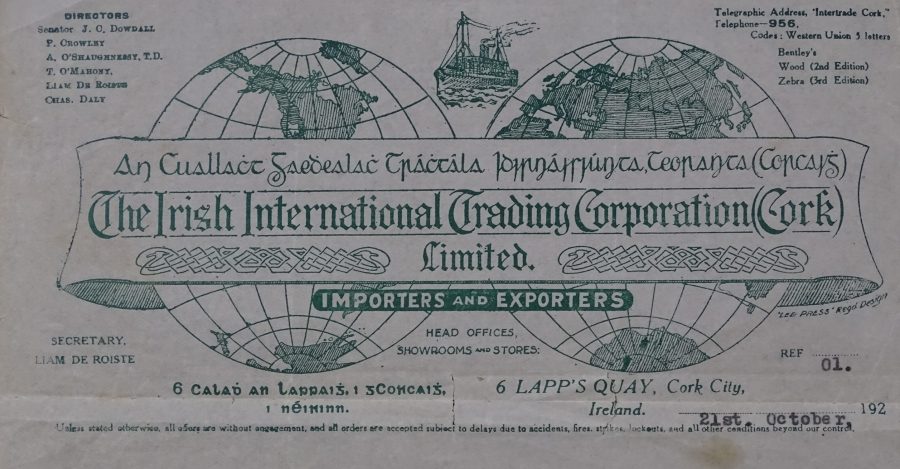
Kieran’s Cork Harbour Festival Events, Early June 2021
– Bridges of Cork – Online Talk:
- 8 June 2021, 19:30 – 20:30, In association with Cllr Kieran McCarthy.
Cork City’s growth on a swamp is an amazing story. The city possesses a unique character derived from a combination of its plan, topography, built fabric and its location on the lowest crossing point of the river Lee as it meets the tidal estuary and the second largest natural harbour in the world. Indeed, it is also a city that is unique among other cities, it is the only one which has experienced all phases of Irish urban development, from circa 600 AD to the present day. Hence its bridges all date to different times of urban growth and possess different architectural traits. This zoom presentation explores the general development of the city’s bridges and why they were historically so important and are still so important in connecting the different parts of Cork City together.
Bridges of Cork – Online Talk ~ Cork Harbour Festival
FREE, Register here: https://forms.gle/pazrXi1nVPQFSqKJ7

– Bridges of Cork Treasure Hunt:
- 12 June 2021, 13:00 – 13:15, In association with Cllr Kieran McCarthy.
They say the best way to get to know a city is to walk it – in Cork you can get lost in narrow streets, marvel at old cobbled lane ways, photograph old street corners, look up beyond the modern shopfronts, gaze at clues from the past, be enthused and at the same time disgusted by a view, smile at interested locals, engage in the forgotten and the remembered, search and connect for something of oneself, thirst in the sense of story-telling – in essence feel the DNA of the place. This treasure hunt is all about looking up and around and exploring the heart of Cork City whilst exploring the stories and place of the city centre’s bridges.
Suitable for all ages, approx. 2hr self-guided walk, mixed footpaths on city’s quays.
FREE, Join: Meet Cllr Kieran McCarthy at National Monument, Grand Parade, Cork, between 13:00-13:15, no booking required. Bring a pen. Self guided heritage treasure hunt.
Bridges of Cork Treasure Hunt ~ Cork Harbour Festival
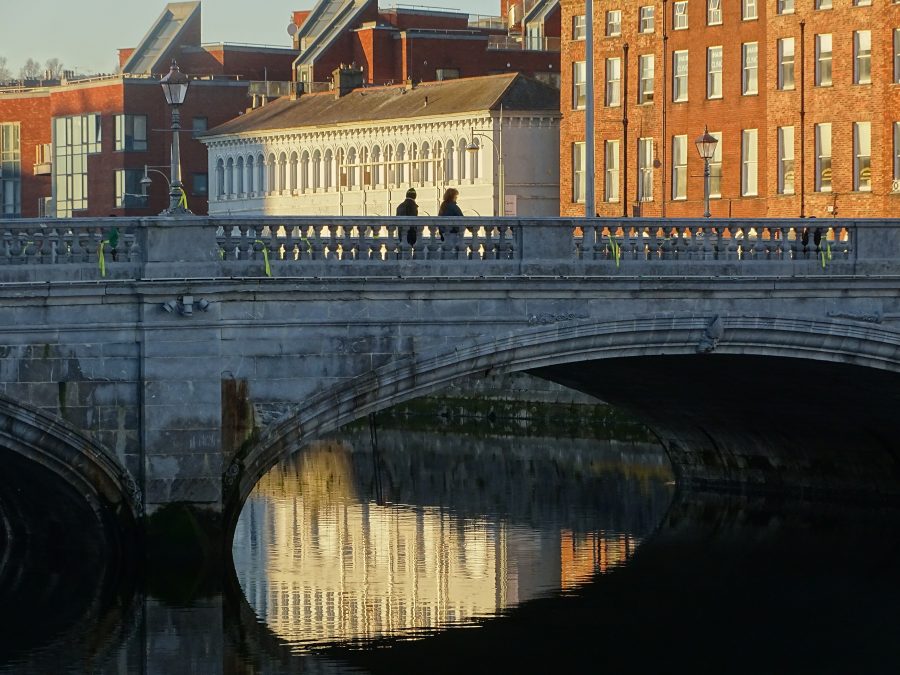
St Patrick’s Bridge, Cork, present day (picture: Kieran McCarthy)
– The Marina – Self Guided Audio Trail:
- 4 June 2021 – June 14, 2021, 06:00 – 23:55,In association with Cllr Kieran McCarthy, FREE
A stroll down The Marina is popular by many people. The area is particularly characterized by its location on the River Lee and the start of Cork Harbour. Here scenery, historical monuments and living heritage merge to create a historical tapestry of questions of who developed such a place of ideas. Where not all the answers have survived, The Marina is lucky, unlike other suburbs, that many of its former residents have left archives, autobiographies, census records, diaries, old maps and insights into how the area developed. These give an insight into ways of life and ambitions in the past, some of which can help the researcher in the present day in understanding The Marina’s evolution and sense of place going forward. Take a walk with us and discover more.
The audio tour will be available here to stream live on your smartphone from 4-14 June 2021, The Marina – Self Guided Audio Trail ~ Cork Harbour Festival

Cllr McCarthy: Former ESB Sub Station Should be a Major City Cultural Asset, 24 May 2020
Independent Cllr Kieran McCarthy has called on the City Council and the ESB to work on a joint programme of works to return the sub-station on Caroline Street to an art gallery/ cultural space.’
The sub station on Caroline Street is in the ownership of the ESB. Until recently the Sub Station was advertised for Commercial Let. Cllr McCarthy has been informed that Cork City Council does not have sight of the ESB’s plans for the building. And that the wider needs in terms of cultural infrastructure in the city will be reviewed in the context of the forthcoming Arts & Culture Strategy, currently under development.
Cllr McCarthy noted; “there is massive scope to do a joint partnership in re-opening the disused ESB substation as a cultural space. It has a very rich industrial history. It was built in 1931 and was originally used to convert direct current electricity to alternating current. This substation is representative of the design employed by the ESB in the first part of the twentieth century in Ireland.
“In 1932, the ESB could boast cables running from Ardnacrusha Hydro Electric Station to Cork as well as having the old generating station and offices at Albert Road, a Station at Kilbarry, a transformer station at Fords, and the central substation in Caroline Street. The annual consumption of electricity in Cork City was 8 million units by 1934 and 16 million units by 1945”.
“The National Inventory of Architectural Heritage notes of this building: “This functional building is a well-articulated building, with a high level of architectural design. The building retains many interesting original features and materials, such as the metal casement windows and metal folding doors”.
“It is also ten years ago when the Triskel Arts Centre, whilst waiting for the renovation of Christ Church, moved its gallery off site to the ESB substation on Caroline Street and did a great job in utilising the space. In addition, in 2018, Brown Thomas teamed up with Cork City Council and artist Shane O’Driscoll to transform the exterior of the then disused ESB station building which had fallen into disrepair. The City Centre Placemaking Fund from Cork City Council was used to support the project”.
“It is a real shame that such a prominent building remains vacant with so many possibilities for its use. I will be continuing my lobbying of the City Council to partner up with the ESB in finding an appropriate cultural use for the building”, concluded Cllr McCarthy.
Press, 25 May 2021, “The abandoned substation has massive scope for transformation now that Cllr. Kieran McCarthy is urging the city council and ESB to turn it into a new entertainment venue for Leesiders. Originally built in 1931 in the art deco style favoured by ESB at the time, the substation was last used by Triskel Arts ten years ago”, Endless possibilities for this gem of a building on Caroline Street to be transformed as council consider new proposal, Derelict Art-deco substation could become amazing Cork city music and arts space – Cork Beo

Cllr McCarthy: Enhanced Recreational Jewels in the Heart of Douglas Village Most Welcome
Independent Cllr Kieran McCarthy has welcomed the conclusion of the Douglas Flood Relief Scheme. “In the past two months, the contractor on the Douglas Flood Relief Scheme has substantially completed all construction works on the project. The remaining works consist of some minor snags, fence installations and completion of final landscaping works”.
“What has emerged are enhanced recreational jewels in the heart of Douglas Village with a larger focus on connecting The Mangala and Ballybrack Woods across to Douglas Community Park. The flood prevention measures, which have incorporated new seating and biodiversity areas and corridors, as well as creating a stronger visual element upon the adjacent stream are most welcome”.
“It has been great in the past few weeks to see people sitting out enjoying the new vistas and ultimately embracing an enhanced community space. Great credit is due to Cork City Council, Arup Engineering and to the OPW. It has been a long process over eight years from draft plans drawn up in connection with Cork County Council to implementation under Cork City Council’s watchful eye. In the past year, the advent of COVID also slowed down construction work, which required much patience by the people and businesses of Douglas”.
“There have also been status orange rainfall events in Cork, since the start of the year and the new flood defences in Douglas worked as expected and carried a huge volume of water through the village safely. From observations and experience on site it is believed that had the defences not been constructed, there would have been considerable flooding in the Ravensdale and Church Road area”, concluded Cllr McCarthy.
Kieran’s Our City, Our Town, 20 May 2021
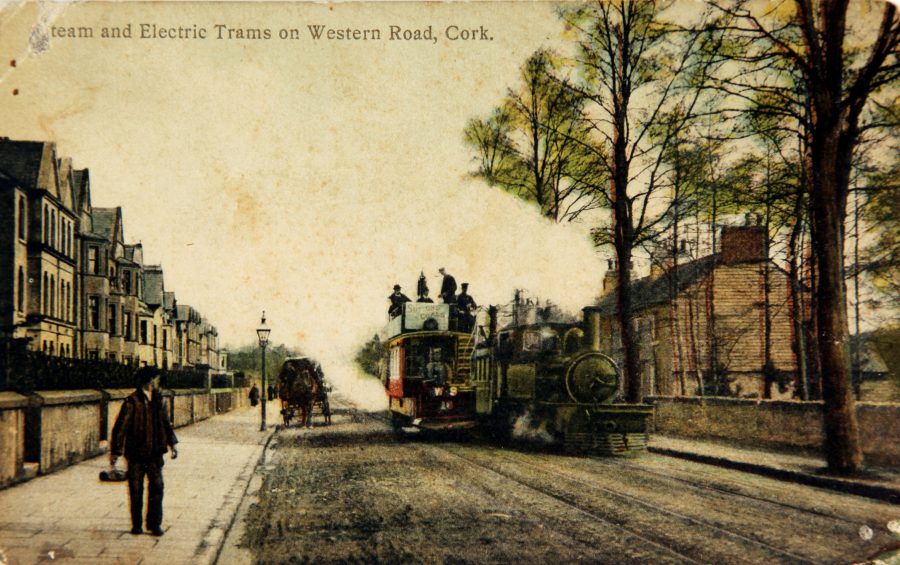
Kieran’s Our City, Our Town Article,
Cork Independent, 20 May 2021
Journeys to a Truce: Stories from the Active Service Unit
Patrick Murray was Officer-in-Charge of C Company of the 1st Battalion of Cork No.1 IRA Brigade. In his witness statement in the Bureau of Military History (WS1443) by May 1921, he was a core part of the Active Service Unit for Cork City. Much of the work of the Unit during this period comprised patrols, moving materials from place to place and taking arms, to columns. The assigned intelligence officers were daily seeking information, which might lead to a successful ambush of Crown forces.
Patrick describes that a number of spies were executed at this time, and a captured report from the British, sometime around May 1921, stated that the last of their intelligence officers in the city had been executed and that they were now without civilian intelligence in the city. This particular type of work was very severe on the mental health of Seán Twomey, who was in charge of the Active Service Unit.
About the beginning of May 1921, a special order was received from IRA divisional headquarters that every effort was to be made by each unit in the division, to carry out an attack on Saturday, 14 May. The Unit decided to concentrate upon Captain Campbell Kelly, who was the principal British intelligence officer in Cork and who had been responsible for the torture of many IRA volunteers and had been sought by the IRA for over five months. He frequently travelled in a motor car to Cork Jail off Western Road, and it had been noticed by the Active Service Unit intelligence officers that Saturday morning was one of his regular mornings to visit the jail.
It was decided that the Unit would take up duty from eight o’clock in the morning along the route usually taken by Kelly. Seán Twomey and Patrick Murray took up position in St Patrick’s Street at about nine o’clock. Things did not go according to plan as Seán faced a an anxiety attack. Patrick got him home but during this time, Kelly had gone up to the jail in an open car and returned from it in an armoured car.
Patrick recalls: “Immediately all members of the A.S.U. and helpers were concentrated in one or two parts of the city to see if something could not be done. Late in the evening, the men on duty at the north side of the city were informed that an R.I.C. patrol had gone down O’Connell Street, Blackpool. They immediately ran to the attack and threw some bombs, killing one and wounding three policemen”.
On the morning of 23 May 1921, plans were again made to ambush Captain Kelly, this time on Washington Street. Two groups from the Active Service Unit took up positions along the street. An intelligence officer was placed some fifty yards or so beyond Patrick and another man. Three other members of the Unit were placed about seventy-five yards below Patrick’s group.
Captain Kelly came from the jail in an open car on this particular morning and had practically passed the intelligence officer before he was recognised. Patricks recalls the throwing of the bombs: “When we got the signal, the car had passed us, and we signalled to the men further down. The car was going so fast that it was practically past them before they threw the bombs. One bomb was thrown into the car but failed to explode. The second bomb hit the hood of the car and rolled on to the roadway. Some shots were also exchanged, but Kelly escaped”.
Days later Seán Twomey was arrested, subsequently walked out of the police barracks, and was fired on by soldiers, receiving some six or eight wounds. Peter Donovan, the new Officer-in-Charge was arrested practically immediately after his appointment. About a week later, Patrick was appointed as Officer-in-Charge of the Active Service Unit. For a week or two he tried to re-group the battalions and replace arrested officers. At that time, everyone in Cork City who was known to have had any association with the Volunteers had been arrested, and casualties among the officers were substantial.
After the attack on the patrol at Blackpool, police patrols became less frequent; in fact, they often did not appear on the streets for five or six days. The Active Service Unit were patrolling the streets regularly at this time, and their intelligence officers were constantly engaged in trying to find out the movements of the police. They noticed that they congregated outside the different barracks for a short time in the evenings and decided to attack them outside Tuckey Street and Shandon Street RIC barracks (on North Abbey Street). To do this, they got two motor cars.
Unfortunately, the driver of the car attacking Tuckey Street had some trouble with the motor and drove the car to the attack about two minutes before the agreed time. As a result of this, some thirty or forty Volunteers, who were leaving their own points to converge on Tuckey Street, heard the bombs before they were in a position to attack. Patrick was forced to withdraw his men. Bombs were thrown though at Shandon Street barracks and Douglas barracks was attacked with gunfire.
Up to this time, the Active Service Unit was equipped only with revolvers and bombs and operated in the city area only. As a result of the attacks on patrols and barracks, the movements of the British were restricted to travelling through the city area in lorries, protected by armoured cars. With this change of tactics on the part of the British authorities, it was decided that the Active Service Unit would extend its operations to the suburbs and country areas.
This article marks the 1100th article in the Our City, Our Town series. Check out the index to the series and the new history trails section on my blog, www.corkheritage.ie.
Captions:
1110a. Western Road with the Cork-Muskerry Tram, c.1910 from Kieran McCarthy’s and Dan Breen’s Cork City Through Time (2012, Amberley Publishing).
Cllr McCarthy: Good Progress being made on Greenway Works
Independent Cllr Kieran McCarthy has welcomed the good progress on the Old Railway Line Walk works. Construction has already began on a new access ramp linking the Marina and the old Railway Line walk.
Cllr McCarthy noted: “This new access point will benefit pedestrians, cyclists, people with disabilities and ensure better access to local communities and visitors. At present, people with disabilities cannot access the greenway between Pairc Uí Chaoimh and the Mater Private access point”.
“A giant game of ‘Snakes and Ladders’, which will include ladders and slides, will form part of the green terraced area surrounding the new access ramp. New seating will also be incorporated, new lookout points and water drinking facilities. There will also be extensive soft landscaping works including significant new tree planting, shrub planting and wildflower meadow planting with native pollinator friendly species”, concluded Cllr McCarthy.
From 10 May, works to resurface, widen and install public lighting on the Blackrock Greenway mean that a section of the amenity between Atlantic Pond and Blackrock Station, will be temporarily closed. Pedestrians and cyclists will be asked to observe the diversions in place. These upgrade works are expected to continue for up to 10 weeks.
The Blackrock-Mahon Greenway Improvement Scheme has been designed to enhance this popular route due to increased usage by pedestrians and cyclists for recreation and commuting. The works are also to encourage and prioritise its ongoing development as a green living corridor with significant health and well-being benefits.
Independent Cllr Kieran McCarthy has welcomed the good progress on the Old Railway Line Walk works. Construction has already began on a new access ramp linking the Marina and the old Railway Line walk.
Cllr McCarthy noted: “This new access point will benefit pedestrians, cyclists, people with disabilities and ensure better access to local communities and visitors. At present, people with disabilities cannot access the greenway between Pairc Uí Chaoimh and the Mater Private access point”.
“A giant game of ‘Snakes and Ladders’, which will include ladders and slides, will form part of the green terraced area surrounding the new access ramp. New seating will also be incorporated, new lookout points and water drinking facilities. There will also be extensive soft landscaping works including significant new tree planting, shrub planting and wildflower meadow planting with native pollinator friendly species”, concluded Cllr McCarthy.
From 10 May, works to resurface, widen and install public lighting on the Blackrock Greenway mean that a section of the amenity between Atlantic Pond and Blackrock Station, will be temporarily closed. Pedestrians and cyclists will be asked to observe the diversions in place. These upgrade works are expected to continue for up to 10 weeks.
The Blackrock-Mahon Greenway Improvement Scheme has been designed to enhance this popular route due to increased usage by pedestrians and cyclists for recreation and commuting. The works are also to encourage and prioritise its ongoing development as a green living corridor with significant health and well-being benefits.
Cllr McCarthy: Working with Residents Crucial on Rochestown Greenway Proposal, 14 May 2021
Independent Cllr Kieran McCarthy has expressed several concerns for the proposed boardwalk concept that was recently presented as part of the ongoing Greenway consultation behind St Gerald’s Place on the Rochestown Road.
Cllr McCarthy noted: “I have walked the foreshore route with the local residents at St Gerard’s Place at low tide and physically a boardwalk would abut many of their back doors, which would be severely intrusive. There is an impression out there that the partial trackways behind the houses can host a 4-5m wide boardwalk. The trackways themselves are just 2m wide with backdoors of some houses fronting onto them. Hence, a safe boardwalk 4-5m wide would literally be passing outside people’s kitchen window. This isn’t even about taking people’s back gardens. There is no physical space there to adapt any kind of laneway.
The other alternative that is being proposed in social media is that to avoid the ‘outside the people’s backdoor’ concept, a raised boardwalk structure could be constructed at the foreshore edge. I have also been back to the site at high tide and high tide comes all the way up to the foreshore edge. Hence, a raised boardwalk concept would literally rip up the upper shoreline. A 4-5m wide boardwalk and something over 300 metres long plus 3- 4 metres high off the shoreline would be highly intrusive and damage the adjacent Special Protected Area of Lough Mahon.
There is also the impression that the old Cork Blackrock and Passage Railway Line ran directly by the shoreline. That is also a misnomer. The line in the mid nineteenth century was built along the Rochestown Road to avoid the high cost of engineering anti shoreline erosion features.
If the greenway must come back to the roadside, it is important that every measure is put in place to have a proper safe and sustainable greenway stretch. I welcome the ongoing dialogue between local residents and Cork City Council to find a solution – of a protected greenway and a widened Rochestown Road space.
And last and most of all, I have concerns about the ongoing bullying of residents on social media and from various opposing sides, and especially by individuals who operate anonymous accounts and who do not sign their name. I am all for dialogue and several people – who did sign their names – have contacted me asking for feedback on the public consultation, who I have laid out my concerns with, but the anonymous trolling has had a huge impact on the mental health of local residents involved in the consultation process, and needs to stop”, concluded Cllr McCarthy.
Kieran’s Our City, Our Town, 13 May 2021
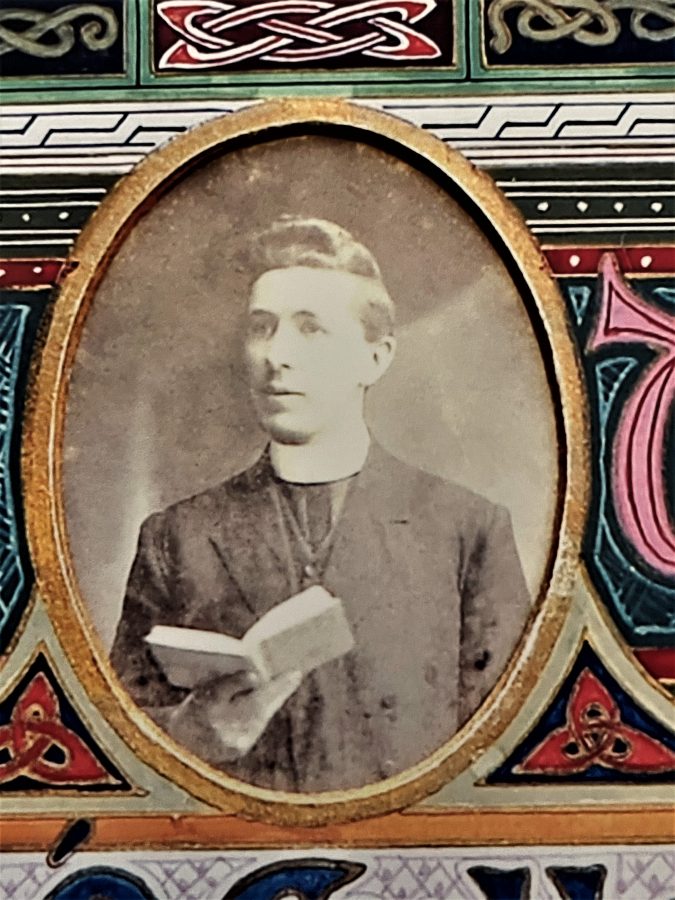
1099a. Fr James O’Callaghan, c.1917 (source: O’Brien family archive).
Kieran’s Our City, Our Town Article,
Cork Independent, 13 May 2021
Journeys to a Truce: Fr O’Callaghan’s Last Stand
Ireland experienced a tragic Whitsuntide bank holiday weekend in mid-May 1921. Many deaths amongst civilians and Crown forces were reported from various parts of the south of the country.
About four o’clock on Saturday evening, 14 May, a bomb was thrown at police in the Blackpool district, near O’Connell Street. One constable was killed and three wounded. One died later on. Large swathes of military and police searched the area with much of Blackpool ransacked. Several arrests were made across the city.
One tragic outcome was the quest to arrest Alderman Liam De Róiste of Sinn Féin on Cork Corporation. In the search for him, instead of Liam being arrested, a renter within his house was shot and died from his wounds. On Saturday night/ Sunday morning, 15 May, Father James O’Callaghan was staying at Liam’s residence in Upper Janemount, Sunday’s Well.
From the Templemartin district, County Cork, Fr O’Callaghan was ordained at St Patrick’s College, Maynooth in 1908. He was a fluent Irish speaker and was a valued Irish teacher in Ballingeary Irish College. He had a ministry abroad between 1908 and 1912 and was curate in Ballingeary from 1912 to 1917. He then became Chaplain at the Good Shepherd Convent between and 1917 and 1920. In 1920 he was made curate of the North Cathedral Parish and at Clogheen Church. he was attached to the convent of the Good Shepherd’s.
Fr O’Callaghan’s new post in the North Cathedral left him with no living quarters. He was an acquaintance of Sinn Féin Corporation member and Teachta Dála Liam de Róiste. He asked Liam for hospitality and was invited to stay at the parliamentarian’s house.
According to a report which Liam sent to Bishop Cohalan after Fr O’Callaghan’s murder, Crown forces raided his house only a few days after Fr O’Callaghan had moved in and treated him roughly.
At the General Elections held in May 1921 under the provisions of the 1920 Government of Ireland Act, Liam De Róiste was an unopposed Sinn Féin candidate for the Cork borough constituency. Afraid that this situation would draw hostile interest from the Crown forces, Liam decided not to sleep in his house at night, leaving Fr O’Callaghan there together with his wife, his mother-in-law and the priest’s housekeeper Katie Kearney. Katie was from Inchigeela and had been a housekeeper of the priest for fourteen years.
On Saturday night /Sunday morning, 15 May 1921 between 3.30am and 4am, a number of armed men broke open the glass-panelled door and rushed into the house. Liam De Róiste was fortunately not there at the time. Liam’s wife Nora, detailed to the Cork Examiner in the days that followed and to her husband for his diary that her mother was present and that both occupied bedrooms immediately over the hall door. Fr O’Callaghan and Katie had their respective rooms at the other side of the house.
Nora enquired who was there and got an order to come down and open the door. She declined. One of the men climbed up a garden trellis and entered a bedroom through the window. She grappled with him and a revolver fell from his hands. Threatening him with a clothes brush she made him back out the window.
Meanwhile, other members of the party of men had forced the opening of the half-door and one man walked up two flights of stairs and branched off to the two other rooms in the house – occupied by Fr O’Callaghan and Katie respectively. They both met the intruder outside their bedrooms. A scuffle ensued between the man and Fr O’Callaghan.
Katie Kearney (years later) penned her memory of the evening and recalls of the scuffle; “As the Tan came up the stairs, he had a cap on his head and a scarf on his neck. I put up my hand to pull off the cap and scarf and was not able to do so. I said to them ‘This is Fr O’Callaghan, you won’t shoot him’. He drilled towards me and the Priest went backwards a few steps. The Tan followed him and pulled him to the bedroom door. I saw him prepare the revolver and I grasped it by the muzzle and as I did one shot rang out against the partition. He shook the revolver out of my grasp and pulled over the Priest and shot him through the spine and paralyzed him, he fell on the corridor, the Tan walked down the stairs and away”.
Father O’Callaghan was seriously wounded in his liver and spine before the raiders took their departure. The Corporation ambulance was summoned, and Fr O’Callaghan was conveyed, still conscious to the North Infirmary. It was there that he detailed that he knew his attacker – a Black and Tan who was on regular duty in and around Shandon Street. Some hours later at 6pm he succumbed to his injuries in the presence of a nurse and Liam De Róiste who prayed for the priest by his side.
Originally the internment of Fr O’Callaghan was fixed for St Joseph’s Cemetery, but by request of the residents of Clogheen, where the deceased ministered, the place of burial was changed to Clogheen. Despite widespread warnings the streets and roads were lined to mark their respect as the funeral cortege passed. A cross now marks his burial place at the Church of the Most Precious Blood. Over many decades, the story of the murder has been passed down by many historians and especially by the O’Callaghan family. Fr O’Callaghan’s coat complete with bullet marks has survived as part of their family heirlooms. Remembrance was also shown through the name of Cork’s Fr O’Callaghan’s GAA Club for several decades.
Many thanks to Mary and Donal Healy, Maureen and Mary O‘Brien, Rita O’Brien, Cork City and County Archives, and Cllr Ken Collins for their help and insights with this article.
Captions:
1099a. Fr James O’Callaghan, c.1917 (source: O’Brien family archive).
1099b. Mary Healy (nee O’Brien) and Mary O’Brien with Fr James O’Callaghan’s priest jacket, present day (picture: Kieran McCarthy).
1099c. Burial place of Fr James O’Callaghan, Clogheen Church, present day (picture: Kieran McCarthy).
